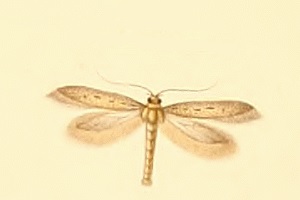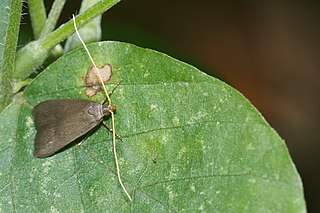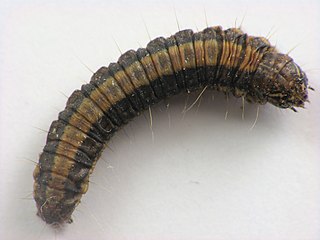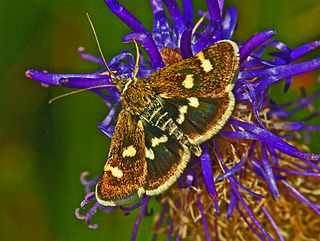Related Research Articles

Pyraustinae is a large subfamily of the lepidopteran family Crambidae, the crambid snout moths. It currently includes over 1,400 species, the majority of them tropical but some found in temperate regions including both North America and Europe.
The Holcopogoninae are a subfamily of moths. They belong to the huge the superfamily Gelechioidea, of which they represent a minor but apparently quite distinct lineage.

German submarine U-383 was a Type VIIC U-boat of Nazi Germany's Kriegsmarine during World War II.

Epidola is a genus of moths in the family Gelechiidae.

The Lecithocerinae are a subfamily of small moths in the family Lecithoceridae. They are found worldwide, but most species occur in South Asia. The subfamily is characterized by the male genitalia with a bridge-like structure connecting the tegumen and the valva, and the uncus almost always is vestigal with two lobes at the dorsal base, only exceptionally united into a broad plate, but never as a thorn or spine.

Metasia is a genus of moths of the family Crambidae.

Loxostege is a genus of moths of the family Crambidae.

Phostria is a genus of moths of the family Crambidae.

Desmia is a genus of moths of the family Crambidae. The genus was erected by John O. Westwood in 1832.

The Chrysauginae are a subfamily of snout moths. They are primarily Neotropical and include about 400 described species.

The Epipaschiinae are a subfamily of snout moths. Almost 600 species are known today, which are found mainly in the tropics and subtropics. Some occur in temperate regions, but the subfamily is apparently completely absent from Europe, at least as native species. A few Epipaschiinae are crop pests that may occasionally become economically significant.
German submarine U-403 was a Type VIIC U-boat of Nazi Germany's Kriegsmarine during World War II.
German submarine U-454 was a Type VIIC U-boat of Nazi Germany's Kriegsmarine during World War II.

Odontiinae is a subfamily of moths of the family Crambidae. The subfamily was described by Achille Guenée in 1854.
German submarine U-709 was a Type VIIC U-boat of Nazi Germany's Kriegsmarine during World War II.
Glaphyriinae is a subfamily of the lepidopteran family Crambidae. It was described by William Trowbridge Merrifield Forbes in 1923
German submarine U-634 was a Type VIIC U-boat built for Nazi Germany's Kriegsmarine for service during World War II. She was laid down on 23 September 1941 by Blohm & Voss, Hamburg as yard number 610, launched on 10 June 1942 and commissioned on 6 August 1942 under Oberleutnant zur See Hans-Günther Brosin.
The Torodorinae are a subfamily of small moths in the family Lecithoceridae.

Margaroniini is a tribe of the species-rich subfamily Spilomelinae in the pyraloid moth family Crambidae. The tribe was erected by Charles Swinhoe and Everard Charles Cotes in 1889.
References
- ↑ Savela, Markku. "Arragonia Amsel, 1942". Lepidoptera and Some Other Life Forms. Retrieved August 30, 2017.
| This article on a moth of the family Autostichidae is a stub. You can help Wikipedia by expanding it. |